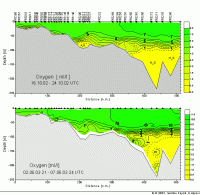

Methane deposits in sediments of the Baltic Sea

The seafloor of the Baltic Sea is an ideal place for methane production. There is a continuous snow of organic matter reaching the floor where its decomposition causes oxygen consumption. In the layered water body of the Baltic Sea, this leads nearly permanently to oxygen deficiency in the bottom water and constant anoxia within the sediments (anaerobic conditions).
These are most favourable conditions for methane producing bacteria. Mayor parts of their methane production will be stored and accumulated in the sediments. Other bacterial communities, which are specialised in using methane for generating energy, provide a barrier which keeps the methane effectively scavenged in the sediments: On a global scale it is estimated that less than 10 % of the methane produced in the sediments is released from the seafloor.
This bacterially directed interaction between methane production and methane oxidation – well known from anaerobic sediments all over the world – can be studied in the Baltic Sea in an ideal way. The hypothesis: if global warming causes changes in the bacterial interaction leading to an increased release of methane from the seafloor into the water and the atmosphere, a feedback reinforcing the greenhouse effect might be expected.